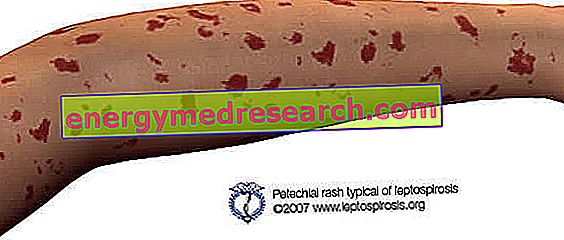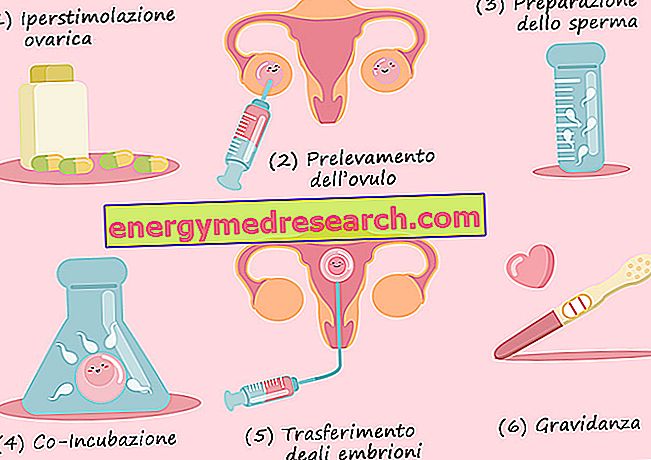Leptospirosis
As analyzed in the previous article, leptospirosis represents a group of infectious syndromes caused by spirochetes of the genus Leptospira. However, it should be pointed out that not all species of these microorganisms are pathogenic to humans: over 200 different serotypes are currently recognized - known with the name serovar - and the serovar icterohaemorrhagiae is certainly the most dangerous and virulent. Among the pathogenic serovariants for man we must also mention pomona, canicola, batavie, grippotyphosa, hyos, sejroe and australis.
In this brief discussion we will describe leptospirosis in terms of symptoms and clinical forms.
Symptoms and clinical forms
To learn more: Symptoms Leptospirosis
The symptomatic picture of leptospirosis is often problematic, especially to outline a complete and exhaustive diagnosis. We have seen that in nature there are many varieties of leptospires, therefore also the clinical and symptomatic picture that follows is often complex and heterogeneous. Furthermore, the severity of the disease is proportional to the inhaled / assumed infecting charge.
In most cases, patients infected with leptospires do not immediately realize the infection, as leptospirosis - at least in the early stages - runs asymptomatically.
The complexity of the disease is such as to make a distinction necessary in three clinical forms (sub-clinical Leptospirosis, Anitteric Leptospirosis and Weil Syndrome or Icteric Leptospirosis).
All three clinical forms may present a biphasic course, in which two distinct phases alternate, the septicemic phase and the immune phase, clearly indistinguishable when the disease occurs asymptomatically.

The following are the general characteristics typical of each stage of leptospirosis, although each of the three forms is distinguished by slightly different signs and symptoms:
Septicemic phase
- Septicemic phase: either leptospirotic phase or acute phase
Generally, the first phase of leptospirosis has a variable duration from 4 to 8 days: it begins with an unexpected and sharp increase in the basal temperature (39-40 ° C), accompanied by severe headache, chills, general malaise, nausea, vomiting and anorexia. Sometimes, the acute phase of leptospirosis is also associated with pharyngodynia and a morbilliform exanthema (see figure); more rarely, the acute acute phase is also characterized by jaundice, usually towards the final stage of the septicemic phase.
The severity of this first phase of leptospirosis varies according to the bacterial species and the patient's state of health.
Immune phase
- Immune phase of leptospirosis: or leptospirulica
Shorter than the first, the immune phase usually lasts 5 days, during which specific antibodies are formed against the bacterium, leptospires in the blood tend to disappear and histological lesions appear on kidney, meninges and liver. Damage to these organs is mainly due to the release of toxins from the blood in the blood: in the kidney there are often marked lesions at the level of the distal nephron, accompanied by interstitial edema, lymphocyte infiltration and destruction of the basement membrane epithelium. At the level of the meninges, a lymphocytic infiltration is often observed and in the liver there is often a necrosis of liver and choleresis cells.
Sub clinical leptospirosis
The subclinical form of leptospirosis - also known as paucisintomatica - most often begins with fever, lower abdominal pain, headache, vomiting, often accompanied by typical flu symptoms. The blood test shows a marked presence of circulating leptospires. Subsequently (the immune phase), the patient becomes ill, leptospires are not found in the blood and specific antibodies appear: in similar situations other manifestations are possible such as uveitis, rash, renal and / or hepatic lesions.
Anitteric leptospirosis
It represents the intermediate form of leptospirosis and constitutes 90% of its symptomatic forms: the symptoms are more severe than the subclinical form, but less severe than Weil syndrome. The patient, in the first phase of the illness, complains of general malaise always accompanied by a marked alteration of the basal temperature (high septic fever); also frequent headaches, chills, vomiting, pain in the lower abdomen and decreased blood pressure. Sometimes, respiratory lung disorders can also be associated.
Headache also persists in the second phase of leptospirosis, while basal temperature values tend to normal; in some patients, a mild fever is observed. Sometimes, aseptic meningitis is diagnosed and lasts a few days, without serious effects. The anitteric form of leptospirosis is often also accompanied by ocular disorders, such as eye pain, conjunctival hyperemia and photophobia. In the immune phase, pathogens cannot be observed in liquor, which appears normal, generally with hyperproteinorrachia (a notable increase in proteins) and normal values of glycorrachia (glucose level within the cerebrospinal fluid, also called CSF or cerebrospinal fluid: 50 -60mg / ml).
Weil Syndrome (Icteric Leptospirosis)
It certainly represents the most alarming and dangerous clinical form among leptospirosis; recent studies have shown that L. interrogans is the pathogen responsible for the disease, although the pathogenetic mechanism is not fully understood.
Liver and kidney damage, often accompanied by bleeding, is the most serious symptom of the syndrome: the lesions are such because the disease is mainly due to systemic vascular damage. Weil syndrome begins with high fever (an analogy with the anitteric form of leptospirosis), always accompanied by evident jaundice (hence, the name leptospirosis "jaundice"), sometimes with renal involvement of varying degrees (oliguria, cylindruria, proteinuria). Possible cases of myocarditis.
Following the septicemic phase, the immune one is characterized by the worsening of hepatic and renal conditions, associated with hyperazotemia and hypercreatininemia. [from the Internal Medicine Treaty, vol. 3 by G. Crepaldi and A. Baritusso]. Rare, though possible, tubular necrosis.
When untreated or neglected, icteric leptospirosis is fatal in 10% of patients: the risk of poor prognosis increases with age and with the degree of jaundice severity.



